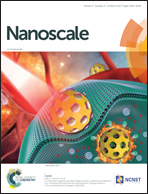A molecular approach to an electrocatalytic hydrogen evolution reaction on single-layer graphene†
Abstract
A major challenge in the development of electrocatalysts is to determine a detailed catalysis mechanism on a molecular level for enhancing catalytic activity. Here, we present bottom-up studies for an electrocatalytic hydrogen evolution reaction (HER) process through molecular activation to systematically control surface catalytic activity corresponding to an interfacial charge transfer in a porphyrin monolayer on inactive graphene. The two-dimensional (2D) assembly of porphyrins that create homogeneous active sites (e.g., electronegative tetrapyrroles (N4)) on graphene showed structural stability against electrocatalytic reactions and enhanced charge transfer at the graphene-liquid interface. Performance operations of the graphene field effect transistor (FET) were an effective method to analyse the interfacial charge transfer process associated with information about the chemical nature of the catalytic components. Electronegative pristine porphyrin or Pt-porphyrin networks, where intermolecular hydrogen bonding functioned, showed larger interfacial charge transfers and higher HER performance than Ni-, or Zn-porphyrin. A process to create surface electronegativity by either central N4 or metal (M)–N4 played an important role in the electrocatalytic reaction. These findings will contribute to an in-depth understanding at the molecular level for the synergetic effects of molecular structures on the active sites of electrocatalysts toward HER.



 Please wait while we load your content...
Please wait while we load your content...